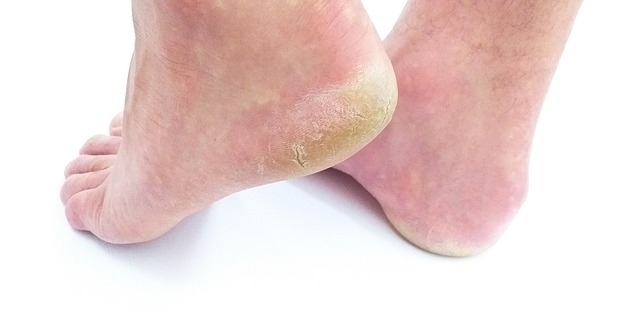Several factors can bring dry, cracked heels into a person’s life. Because our feet are responsible for supporting the weight of the rest of our body, they are subjected to a significant amount of pressure. The skin on the heels of our feet swells and spreads outwards when it is subjected to weight and pressure. As our skin is dehydrated, it loses some elasticity and becomes stiffer, making it more prone to fissures and cracking.
The following are some of the most common causes of cracked heels:
- Medical conditions including obesity, diabetes, eczema or hypothyroidism
- Infections such as athlete’s foot
- Biomechanical factors such as heel spurs or flat feet
- Standing for long periods, particularly on hard flooring
- Dry, cold weather
- Open-toed or poorly fitting shoes
Common Reasons for Cracked Heels
There is a frequent misconception that if someone has dry or cracked heels, all they need to do is grab a bottle of lotion. But, the most common cause of dry or cracked heels is an illness called athlete’s foot. Most people do not struggle with the aforementioned medical illnesses or risk factors. The fungal infection known as an athlete’s foot typically manifests itself on the bottoms of the feet and in the spaces between the toes. Athlete’s Foot is a prevalent condition among athletes. Skin that is itchy, dry, and scaled is a common symptom of athlete’s foot. The affected area may develop irritation, cracks, and blisters in more complex situations. Since athletes frequently have sweaty feet and utilise the facilities where the fungus is located, the condition is popularly referred to as “athlete’s foot.”
The mould-like fungus known as dermatophytes is responsible for the infection known as athlete’s foot. These fungi thrive on dead skin and nails. Athlete’s foot and other fungal illnesses, such as ringworm and jock itch, share a tight relationship. The dark, warm, and wet conditions are ideal for these microorganisms’ survival. Fungal growth and infection are encouraged by damp conditions, such as those found in socks and inside shoes.
How Common are Cracked Heels? Do They Require Treatment?
After most of the potential causes listed above have been eliminated, a fungal infection is the most likely explanation for cracked heels. If the condition is not adequately treated, it may spread to the nails, causing discolouration and fungal nails.
In its early stages, athlete’s foot can be treated using medicinal powders, creams, sprays, or lotions that are available over-the-counter and are mainly developed to combat the athlete’s foot fungus. In its later stages, the condition cannot be cured. When the condition is more severe, a topical medicine that requires a prescription may be necessary. Your physician may recommend an oral antifungal medication for you to take in more severe situations.
Concerning the season, most people will suffer from athlete’s foot or cracked heels during the winter. This is because people tend to wear bulkier footwear, such as boots and shoes, which allow for less air circulation and may be subjected to more moisture due to rain or snow. These infections are still widespread during the warmer months because more people attend public pools and gyms and frequently roam around barefoot in these kinds of establishments.

